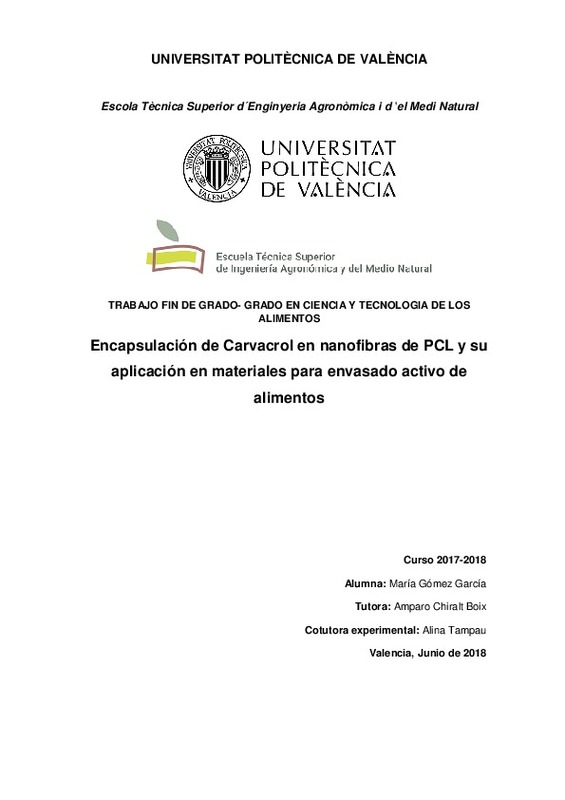|
Resumen:
|
[ES] Se han estudiado las propiedades funcionales de films multicapa activos
biodegradables de almidón, con incorporación de Carvacrol (CA) encapsulado en fibras
de Policaprolactona (PCL) obtenidas mediante Electrospinning ...[+]
[ES] Se han estudiado las propiedades funcionales de films multicapa activos
biodegradables de almidón, con incorporación de Carvacrol (CA) encapsulado en fibras
de Policaprolactona (PCL) obtenidas mediante Electrospinning (ES). Los films de
almidón se obtuvieron mediante mezclado en fundido y moldeo por compresión y sobre
estos films se electro-depositó una disolución de PCL con o sin CA durante diferentes
tiempos. Los films con nanofibras se cubrieron con otra capa de almidón para obtener los
films multicapa por termocompresión. Así, se obtuvieron 5 formulaciones, dos de ellas
con solo PCL entre las capas almidón (con 60 y 90 minutos de electrodeposición), SP1S y
SP2S respectivamente y dos formulaciones incorporando CA para los mismos tiempos,
SP(CA1)S y SP(CA2)S, respectivamente. También se obtuvo un film control con doble
capa de almidón (SS). Los films multicapa acondicionados a 53% de humedad relativa se
estudiaron en cuanto a sus propiedades ópticas, barrera al oxígeno y al vapor de agua y
propiedades mecánicas.
Las fibras obtenidas por ES se analizaron en cuanto a su cinética de liberación del
compuesto activo en diferentes simulantes alimentarios con distinta polaridad. Las fibras
mostraron una velocidad de liberación del CA mayor, con liberación casi total, en los
simulantes menos polares, D1 (etanol 50%) y D2 (Isooctano) (que emulan alimentos
grasos), debido a la mayor afinidad del compuesto con estos líquidos apolares. Los films
con electrodeposición de PCL, con o sin CA, mostraron valores menores de
permeabilidad al vapor de agua, debido a la naturaleza hidrofóbica de la capa de fibras y
su efecto barrera en la multicapa. No obstante, no mostraron reducción en permeabilidad
al oxígeno, que ya fue baja en los films con solo almidón. Con respecto a las propiedades
ópticas, las multicapas presentan valores de brillo relativamente bajos (aspecto mate),
una claridad (L) media y tonalidad (h) ligeramente amarilla. En cuanto a las propiedades
mecánicas, la presencia de la capa electrodepositada dio lugar a una disminución de la
rigidez y resistencia a la rotura de las multicapas. La extensibilidad se vio afectada con la
presencia de las capas con CA, reflejando la migración del activo a la capa de almidón, lo
que debilitó la matriz.
[-]
[EN] The present work studies the functional properties of active biodegradable starch films
with encapsulation of Carvacrol (CA) by the Electrospinning (ES) technique. For this,
starch films were obtained by melt mixing ...[+]
[EN] The present work studies the functional properties of active biodegradable starch films
with encapsulation of Carvacrol (CA) by the Electrospinning (ES) technique. For this,
starch films were obtained by melt mixing to obtain the pellet and compression molding
using a hydraulic press to obtain the films. On these films, a solution of the biodegradable
polymer Polycaprolactone (PCL) with and without Carvacrol was electro-deposited by
means of ES and with different times of electro-deposition to obtain the different
formulations with which to work in the subsequent tests. Thus, 5 formulations were
obtained, two of them with only PCL and starch, at ES duration of 60 and 90 minutes,
SP1S and SP2S respectively and two formulations incorporating Carvacrol for the same
times, SP (CA1) S and SP (CA2) S, respectively. A control film was also obtained for the
tests based on only starch (SS). Once the films were obtained incorporating of the active
components, they were thermo-sealed in a hydraulic press in order to obtain the multilayer
material.
The fibers generated by ES were analyzed in terms of their kinetics of release of the
active compound in different food simulants with different polarities. The fibers showed a
higher rate of release in the less polar simulants, D1 (ethanol 50%) and D2 (Isooctane)
(related to fatty foods) and, on the other hand, in these simulants an almost complete
release of the CA was noted, due mainly to the affinity of monoterpene with these
nonpolar substances.
The starch films carrying electrospun fibers were studied in terms of their optical
properties, oxygen barrier, water vapor barrier property, moisture content and mechanical
properties. With the addition of the electro-deposited layer of PCL and CA, a reduction of
water vapor permeability values against the starch-only film was observed, due to the
hydrophobic nature of these two compounds in the films. Regarding oxygen permeability,
the presence of PCL did not significantly modify this property that was already exhibited
by the thermoplastic starch. With regard to the optical properties, the multilayers have
brightness values less than 40 which can be considered matt, have an average lightness
(L) and a slightly yellow hue (h). Regarding the mechanical properties, the presence of the
PCL layer generated a decrease in the rigidity and breaking strength of the multilayers.
The extensibility was affected with the presence of the layers containing the CA, observing less elasticity, perhaps due to the migration of the active, with weakening
effect, in the starch layer.
[-]
|







